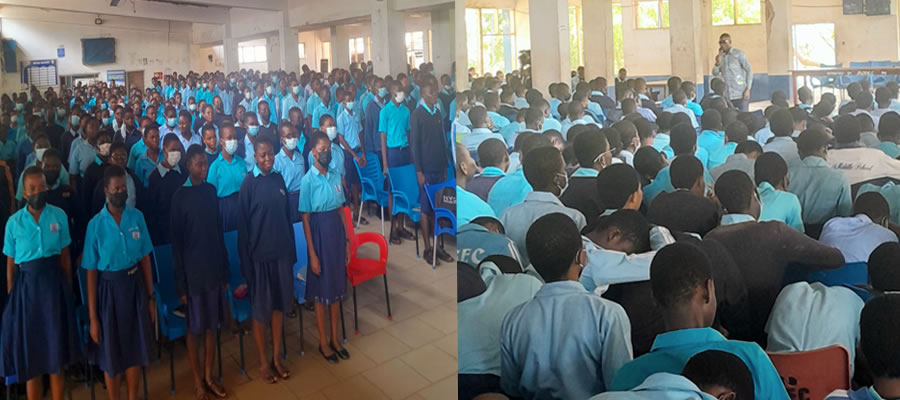

Introduction
The population size, composition and distribution has important social and economic implications. The population size and composition, for example, determines the manpower requirements of the district as well as planning for social services such as education, health, and housing. The age-sex composition of the population determines future fertility, mortality migration and other demographic processes that determine population growth and ultimately the overall socioeconomic development of the district.
Population size and distribution
Table 2.1 presents information on the population of Asuogyaman District by age, sex and locality. Table 2.1 shows that the district has a total population of 98,046, representing 3.7% of population of Eastern Region. Out of the total population there are more females (52.0%) than males (48.0%).
The table further shows that Asuogyaman District is essentially a rural district; majority of the people in the district live in rural areas (70.6%) compared to urban areas (29.4%).
Table 2.1 also provides information on the sex ratio. The sex ratio measures to number of males to females in the population. The observed sex ratio of 92.2 in the table indicates that for every 92 males there are 100 females. The sex ratio is relatively lower in the urban areas (88.2) compared to the rural areas (93.8) as indicated in Table 2.1.
Age-Sex Structure
Figure 2.1 presents the age structure of the population of the district by broad age group and sex. The table shows that the district has a youthful structure with a broad base consisting of large numbers of children and a narrow apex of older population.
The phenomenon confirms assertion that large cohorts are born at a particular year, decreasing population can be attributed to either migration, death or both. For both sexes, more females than males survive to higher ages although more males than females are in the age group 0-14 years.
Dependency Ratio
The dependency ratio which measures the ratio of dependent population (population aged under 15 years and above 64 years) to population in the “working-age group” (population aged 15-64 years) is one of the key indicators of socioeconomic development. Generally the ratio is high in developing regions of the world than developed regions, reflecting 18 demographic experiences of the two regions. Table 2.2 provides information on dependency ratios for Asuogyaman district. The district total age dependency of 75.9 dependents (child and old age) to 100 working population is quite high. Child dependency makes up a substantial portion of the total dependency ratio. For the sexes old age dependency is relatively high for the female population (11.4) than the male population (8.8).
Fertility, Mortality and Migration
Fertility, mortality and migration are the three components of population change that determine the size, age-sex composition and distribution of the population at a particular point in time. Data on these three components are critical for planning the overall socioeconomic development of the district.
The objective of this section of the report is to provide analysis of fertility, mortality and migration patterns in the district using data from the 2010 population and housing census.
Fertility
Measures of fertility are important in determining the size and structure of the population. Information on fertility in the district is therefore critical for the management of the population for social and economic development. This section reports on fertility levels in the district.
Two types of fertility measures are used to examine levels of fertility in the district. These are current fertility measures and cumulative fertility measures. Current fertility measures such as total fertility rate (TFR) are based on data covering a short period of time such as a year ( in the case of population censuses) or five years (in surveys), while cumulative measures such as mean children ever born are based on retrospective fertility data covering women’s reproductive performance over their lifetime.
Current fertility
The most commonly used measures of current fertility are the total fertility rate (TFR). It is defined as the number of children a woman would have by the end of her childbearing years if she were to experience the currently observed age-specific fertility rates.
Table 2.3 shows reported total fertility rate, general fertility rate and crude birth rate by district for Eastern Region. The table shows that 2,354 births occurred in the district in the 12 months preceding the census. The Total Fertility Rate (TFR) for the district is 3.1, which is lower than the regional average of 3.5. This means that woman living in the district would 19
have, on average, 3.1 children at the end of her reproductive period (15-49 years) if the current age specific fertility rates continue to prevail.
The table also presents other fertility measures. The General Fertility Rate which indicates the number of births per 1,000 women of reproductive age (15-49 years) is 89.5 compared to the regional average of 103.9. Similarly, Asuogyaman District’s Crude Birth Rate of 22.7 per 1,000 population is lower than that of the regional average at 25.4 per 1,000 population.
Lifetime fertility (mean number of children ever born)
The mean number of children ever born per woman measures the lifetime or cumulative fertility performance of female respondents in the reproductive age group 15-49 years. Table 2.4 shows the children ever born to the female population 12 years and older by age. Overall, the table indicates that the district average of completed family size for women aged 12-54 years was 2.6 children per woman. As expected the average number of children ever born increases with age with the figure far higher among older wome.
Mortality
Mortality refers to all deaths that occurred in the household during the 12 months preceding the Census Night. Mortality, as one of the three components of population growth, plays an important role in determining the growth of a population. Data on mortality provide an indication of the health of the population as well as a measure of the living condition of the people.
The death rate (also called the crude death rate) is the number of deaths per 1,000 population in a given year. From Table 2.5, there are 853 household deaths in the district with death rate of 8.7 deaths per 1000 live births. Yilo Krobo (13.6) and Kwahu East (12.9) are among the highest death rates in the region.
Age specifics death rates
The reported age specific death rate by sex is presented in Figure 2.2. Generally, mortality is high at birth for earlier ages of life, reduces sharply from age 0-4 to 5-9 years and remain low till ages 15-19 years and start to increase for older ages with the rate of increase becoming very high from age 45 and above.
From under 5 and age 5-9, death rate among the females and males are almost the same and remain equal till age 25-29 years. Thereafter, death rates among females is relatively high than males till age 44 years. Death rate after age 45 is high for males than females.
Table 2.6 shows the causes of deaths in households. From the table, there are 853 deaths in the district compare with the regional and national deaths of 21,519 and 163,534 respectively. Out of the total deaths in the district, 10.0 percent is caused by accident/violence/ homicide/suicide whiles 90.0 percent are due to other causes.
Migration
Migration refers to change in usual place of residence. A migrant is therefore defined as a person whose usual place of residence is different from his/her place of birth or previous residence. The importance of measuring migration lies in its impact on the population size, structure and distribution in the district.
Migration is difficult to measure due to its repetitiveness and difficulty in establishing direction and permanency of the event. Nevertheless census information on birthplace and duration of residence is used to discuss migration patterns in the district. At the district level, migration may involve the movement of people between the district and other localities in the Eastern Region (intra-regional migration) or the movement of people between the district and other regions in Ghana.
Table 2.7 shows that the district has a total migrant population of 44,464, of that number, 16,587 persons were born elsewhere in the Eastern Region, while 27,777 were born in another region in Ghana. The largest number of migrants who moved to the district are from the Volta Region (15,737), followed by Greater Accra Region (4,187) and Ashanti Region (1,906). The lowest number of migrants came from the Upper West Region (105).
With regard to the duration of residence, Table 2.7 indicates that the highest proportion of migrants (44.4%) had lived in the district for more than 10 years, followed by those who have lived in the district for between 5 to 9 years (15.9%). Only about 14.0 percent of the migrants have lived in the district for less than one year. In addition, more than one in five of migrants from the Volta Region (28.2%), Central Region (23.5%), and Upper East Region (22.4%) have lived in the district for 20 years or more.
Date Created : 11/23/2017 4:12:47 AM












 facebook
facebook
 twitter
twitter
 Youtube
Youtube
 +233 593 831 280
+233 593 831 280 0800 430 430
0800 430 430 GPS: GE-231-4383
GPS: GE-231-4383 info@ghanadistricts.com
info@ghanadistricts.com Box GP1044, Accra, Ghana
Box GP1044, Accra, Ghana